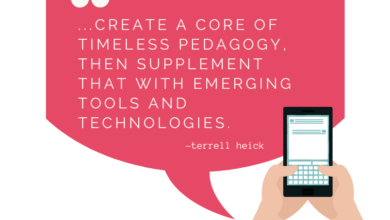8 Strategies Your Teaching More Enjoyable This Year –

by Terry Heick
My wife is a schoolteacher, and recently I’ve been listening to her online meetings.
And there have been a lot of them.
It’s July 2024 and a week or three from the beginning of the 2024-2025 school year in the United States depending on your local school district’s schedule.
Yesterday, I was at a cafe sitting next to what seemed to be a group of teachers and they had a lot of ideas.
And a lot of enthusiasm.
Over the low but constant noise of most cafes, some words and phrases were audible:
Data.
Goal.
Standards.
Vision.
Fidelity.
Roll out.
More about data.
Activity.
Track.
Something about dots and dot walls and data walls.
They talked about goals.
Parents.
Groups and grouping.
Tracking.
Programs.
Data, again.
Fidelity, again.
Communication.
The district.
More tracking (based on grouping and data).
The gist of it all was clear and I could hear the eagerness and buzz lifting up away from the table. It’s July and school is starting soon and there are things to do and teachers are clearly busy, busy, busy.
But it wasn’t just buzz. The was more to it. Something just beneath the surface.
Mindnumbing-ness
My wife has had 8-10 of these meetings since late last week—faculty trainings where she’s being trained on things she needs trained on and then faculty meetings to discuss the schedule for upcoming trainings.
It’s exhausting to hear but, with only a few exceptions here and there, it is all numbing. There is a kind of forced energy but the numb bit is both a cause and effect: another year, another series of sprints.
A few thoughts–
Teaching is a lot work. A lot.
This has always been true but, for many educators, it’s gone from exhausting to unsustainable.
All of the planning and energy busts are followed by something close to a slog or dredge, which itself is followed up by an annoyed kind of fatigue, and then finished as entirely depleted by the end of the school year.
Of course, this varies greatly from teacher to teacher. It depends on factors, including building and climate, mindset, relationships with parents, student engagement, and classroom management, the function of various standards in your teaching and curriculum, the quality of the PLCs—if they are used in your building—and so on.
So much goes into teaching, and so describe the profession as an exhausting slog that is barely endurable by the end of the year is a magnificent over-generalization and probably disillusioned.
The point here isn’t necessarily to mark the general satisfaction of teachers over the course of the school year, but rather to notice the passion and enthusiasm of many teachers in July and how it will, sadly, wain as the year progresses.
Policies vs Children
There is so much to do and plan and prepare and create spaces for that there is very little left for human conversations about the teacher and about the student. That’s the broadest lesson here, for me.
July energy is markedly different from the spring semester.
And this isn’t just a matter of energy being higher and lower. Rather, as the school year continues, there is a shift from vision and creativity and even a bit of enthusiasm, to a quieter and plainer sense of effort.
Take ‘July’ as a metaphor—a bridge month from the summer to the upcoming school year. (The idea of the teachers get the summer off is a dated one, but that’s another post entirely.)
The level of energy from teachers in July is often, and understandably, much higher than it is in late November, never mind March or April of the following year.
July is a beginning.
A Few Strategies For Sustaining Your Enthusiasm For Teaching During The School Year
1. Pace Yourself
Pacing, as an obvious solution here, requires the luxury of pacing, which many teachers don’t have.
The idea is that the energy levels that are both tempting and often necessary before the school year starts can often set schools up for failure because educators create these necessary, set of plans to try to meet student needs and start off with the best intentions simply.
2. Create Moments
Or recognize them, but whatever you do appreciate. Just as it can be difficult in life—but also rewarding—being present for the individual moments during a lesson, for a small group activity, or conversation with a student all gather to create a larger body of work called teaching.
2. Set Realistic Goals
Setting achievable goals helps maintain motivation and reduces burnout. Break the school year into manageable segments with specific, attainable objectives for each period.
Create a yearly plan with milestones and celebrate small victories along the way. This could include mastering a new teaching strategy, implementing a successful project, or simply staying on top of grading.
3. Prioritize Self-Care
This can be, just as a can be in your personal, but self-care is absolutely essential for sustaining energy and enthusiasm. Taking care of your physical, emotional, and mental health helps you stay resilient and positive.
Schedule regular exercise, maintain a balanced diet, and ensure you get enough sleep. Incorporate relaxation techniques such as mindfulness or yoga into your daily routine. Make time for hobbies and activities that bring you joy outside of teaching.
4. Build a Support Network
A strong support network can provide encouragement, share ideas, and offer emotional support during challenging times.
Connect with colleagues, join professional learning communities, and participate in teacher groups or forums. Regularly meet with a mentor or coach for guidance and feedback. Don’t hesitate to seek help when you need it.
5. Stay Organized and Efficient
Organization and efficiency in planning and classroom management can save time and reduce stress, allowing more energy for teaching.
Use tools like planners, apps, or digital calendars to keep track of tasks and deadlines. Develop routines for common tasks such as grading, lesson planning, and classroom setup. Delegate responsibilities when possible and use time-saving teaching strategies, such as flipped classrooms or project-based learning.
6. Reflect and Adapt
Regular reflection helps identify what’s working and what isn’t, allowing for adjustments that keep your teaching practice fresh and engaging.
Set aside time each week to reflect on your teaching. Keep a journal to document successes and challenges, and brainstorm ways to improve. Solicit feedback—formal or informal—from students and colleagues and be open to trying new approaches or techniques.
7. Social-Emotional Teaching
and so far as you were able, try to create learning activities and lessons that lend themselves well to joy or fun or positive experiences for both the students and yourself. It’s hard for teaching to be fine, and sustainable, the work.
8. Embrace It All
That doesn’t mean to lower your expectations, but to realize that an all professions there are challenging times or facets of the job they can feel draining.
Teaching is unique and that it is a kind of mix of procedure and creativity, and that can make it both a challenge and an opportunity to enjoy.





